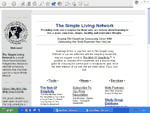5.10.5.10 In Detail
Reducing your use of water, energy and minerals, and caring for the natural environment.
Click to jump to:
- Water Resources And Use In Adelaide - The Facts
- The Web of Simplicity - The Simple Living Network
If you have ever wondered whether your lifestyle choices make a difference, explore this site
www.leas.green.net.au/index.htm
WATER RESOURCES AND USE IN ADELAIDE - THE FACTS
Adelaide derives its reticulated water supply from two sources -
- The Adelaide Hills (Mount Lofty Range); and
- The River Murray.
In an average year, the quantities supplied are 60% (108 gigalitres or GL) from the Adelaide Hills and 40% (72 GL) from the Murray. The total quantity is used, approximately, as follows -
- 70 GL on in-house (domestic) demand;
- 50 GL on lawns and gardens; and
- 60 GL by industry/commercial users.
This translates into over 300 litres of water used every (average) day by each resident (man, woman and child) in their homes, including lawn/garden irrigation. It is well accepted that the average minimum daily needs of humans to sustain life is three litres of water per day, so the average Adelaide resident consumes (various uses) over 100 times this minimum.
The water transferred to Adelaide from the River Murray, has a salinity content which is, at times, around 1 000 ppm (parts per million) which is around double the WHO standard for an 'acceptable' potable supply. This water is mixed in the Adelaide distribution system with water from the Adelaide Hills to give the city a supply which frequently runs close to the WHO limit. The future scenario for Adelaide as salinity levels in the River rise, as expected, is a major cause of concern for both the Government and for water agencies.
A second regrettable aspect of the city's water resource/use situation related to the River Murray, is the energy consumed - and therefore greenhouse gases generated - in transferring quite massive quantities of water by (two) pipelines, 80 km long and traversing the Mount Lofty Range. The quantities of both of these items (energy and greenhouse gases) are unknown (can anyone reading this help put a figure on them?) but they are certainly great.
A further consequence of Adelaide's consumption of River Murray water which impacts unfavourably on householders is its effect on the life of hot water systems. It is estimated that the lifespan of a unit using current Adelaide water is about half that of a system using only rain tank water.
Then there is the issue of the River itself and its value as a water environment providing habitat for a wide range of native fauna and flora. The River, too, has intimate links with past generations of indigenous people and early settlers and occupies a vital place in the lives of many thousands of people who work by it or avail themselves of its bountiful recreational resources. The Murray is a national treasure whose good health must be preserved.
We therefore have at least five good reasons - our profligate use of water, salinity in the Murray, energy consumption, greenhouse gas production and River Murray conservation - why the people of Adelaide should take serious steps to reduce their daily mains water consumption.
How we should do this an easy to answer question: the answer lies in readily available devices and systems such as rainwater tanks, "Rainsaver" guttering, moisture-controlled irrigation systems and water-conserving shower heads, washing machines and dishwashers. The technology is available: all that is needed is the necessary community-wide commitment to the task.
 The Web of Simplicity - The Simple Living Network
The Web of Simplicity - The Simple Living Network
"A step-by-step guide for those who are serious about learning to live a more conscious, simple, healthy and restorative lifestyle."
Information provided by:
John R Argue
Adjunct Professor of Water Engineering
University of South Australia
